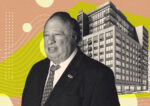
Trending
Manhattan office availability keeps on climbing
Net sublease availability declined for 2nd consecutive month
It was another record month for Manhattan’s office market — but not in the way landlords are hoping for.
Manhattan’s office availability rate hit another all-time high of 17.1 percent in May, according to Colliers International’s monthly market snapshot.
Overall, 1.53 million square feet of office space was leased in May, up 8.2 percent from a year ago. The average asking rent last month was $73.26 per square foot, a decrease of 7.5 percent from the same time last year.
Still, leasing volume was slightly lower than the 2020 monthly average of 1.58 million square feet and less than a half of the 2019 monthly average of 3.58 million square feet. Monthly absorption was negative at 3 million square feet.
Read more


Supply outpaced demand partly because of millions of square feet of space that had been scheduled to come on the market even before the pandemic. That included 673,000 square feet of space at 295 Fifth Avenue and 459,000 square feet of space at 360 Park Avenue South, said Franklin Wallach, Colliers International’s senior managing director for New York research.
The largest lease signed in May was the U.S. Security and Exchange Commission’s 303,000-square-foot extension at 200 Vesey Street. The biggest new lease was signed by financial services company Fiserv, which took 94,000 square feet at 1 Broadway, followed by Anthem’s 72,700-square-foot lease at Penn 1.
On the bright side, net sublease availability decreased for the second consecutive month. Manhattan’s sublease inventory, which has increased by 75 percent since the onset of the pandemic, stood at 20.92 million square feet at the end of May. The sublease share in total availability in May was 22.8 percent, the lowest that’s been since July 2020.
The decline was partly attributed to companies that decided to reoccupy spaces that they had once marketed for subleasing, Wallach said. But he cautions that it’s too early to tell whether this is the beginning of the end of the sublease surge.




